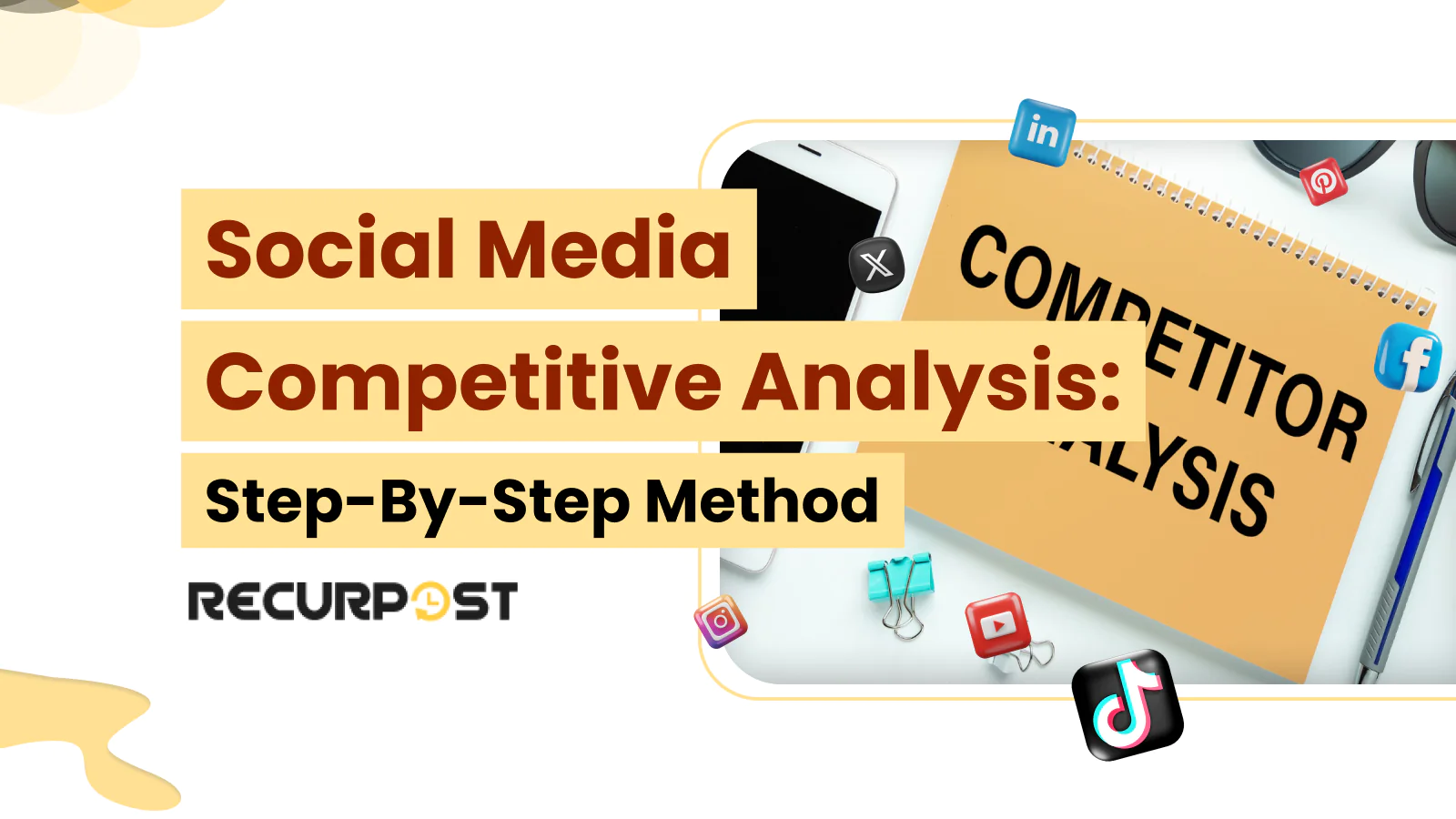If you’re managing digital campaigns, staying sharp on social platforms isn’t optional. Social media competitive analysis shows what others are doing well, where they stumble, and how you can move past them.
With this process, you can spot patterns in what’s working and find gaps others miss. A clear social media competitive analysis example helps uncover what’s happening in your space, before the crowd catches on.
You’ll learn the tools and steps that help track competitors, spot what grabs attention, and make smarter choices for your next post.
What is Social Media Competitive Analysis?

Social media competitive analysis means watching what others post, how often they show up, and what kind of buzz they create. You’ll see which content types spark reactions, track their engagement rates, and compare follower growth across platforms.
It’s a way to spot what’s working, without guessing. From content mix to posting frequency, you can map what drives attention and where your brand stands. With real numbers from your space, social media competitive analysis shows what others nail and where they stumble. It gives you the edge to adjust fast and stay visible.
Social Media Competitive Analysis Template
Try the free social media competitive analysis template made for PrimeNest Realty. It’s built to make comparisons easier. This version helps track what counts as likes, follower jumps, content mix, and posting rhythm across any brand you watch. We’ve added a sample from PrimeNest so you can see how it works in real time.
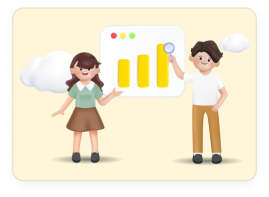
Different industries require customized social media competitive analysis approaches. Here are industry-specific templates you can adapt:
1. Retail/ecommerce
- Compare product promotions
- Look at how brands use Instagram Shop or Facebook Marketplace
- Track how they reply to reviews
- Watch the seasonal post-performance
- Note how visuals push interest
2. B2B Services
- Compare expert content across brands
- Spot how they build interest and collect leads
- Look at testimonials and case studies
- Watch how they engage on LinkedIn
- Track how well webinars perform
3. Food and Beverage
- Look at image quality and style
- Count posts from real fans
- Watch how they connect locally
- Track interest in promos
- Note who they team up with for reach
Key Metrics to Track in Social Media Competitive Analysis
These markers show how others perform on social platforms. A well-built social media competitor report brings it all together, allowing you to identify gaps and set the pace in social media marketing.

- Follower Growth Rate: Use social media competitive analysis to compare growth trends. Is their fan base growing faster? It could mean stronger traction or better content consistency.
- Engagement Rates: Reactions, shares, and replies reveal what sparks interest. Use this to spot what content gets attention and build fresh ideas for your own page.
- Content Mix + Posting Rhythm: Are they going heavy on reels or quick posts? Tracking their pace and style gives you a clear view of their content habits.
- Hashtags + Share of Voice: Which tags are they using most? Are they part of the talk in your niche? This shows where they’re present and where you’re not yet.
- Post Timing: Look at when they post and how that lines up with reactions. Matching their timing might help you stay on radar longer.
Tracking these numbers shows where you’re slipping and where you can pull ahead.
Conduct a SWOT Analysis

A smart social media competitive analysis often includes a SWOT breakdown: Strengths, Weaknesses, Opportunities, and Threats. It shows where your brand stands and where others might be pulling ahead.
This helps spot what’s going well, what needs work, and what might shake things up down the road. In a social media competitor analysis, SWOT points out how others perform—where they shine, where they stumble, and where the space is still wide open.
Strengths:
- What content or formats bring the most reactions?
- Are they winning on one platform more than others?
- Do they have a loyal, active follower base?
Weaknesses:
- Is their engagement weak in some places?
- Do their posts feel flat or repetitive?
- Are they ignoring content types like stories or reels?
Opportunities:
- What trends or topics are they missing?
- Can you speak to an audience that they’re not reaching?
- Are there hashtags or communities they’re skipping?
Threats:
- Are new brands gaining fast with strong content?
- Are changes in user behavior or algorithms affecting you more than them?
- Do their ad campaigns or influencer posts reach your crowd better than yours do?
Here are the questions you can ask for each section of the SWOT analysis:
| Strength | Weakness | Opportunities | Threats |
| What content or strategies are driving the most engagement for competitions? | Are there any platforms where they have a weak presence or low engagement? | Are there industry trends or emerging platforms they are missing that you can capitalize on? | Are there new competitors entering the space with strong social media strategies? |
| Which platforms are they performing best on, and why? | Do their posts lack variety or creativity? Is there a content format they’re underutilizing? | Are there content gaps or topics they aren’t covering that resonate with your audience? | Is their audience growing faster than yours, and if so, what are they doing differently? |
| Do they have a larger, more active follower base compared to your brand? | Are they slow to adopt new trends or features on social media (e.g., TikTok, Instagram Reels)? | Can you target a demographic or interest group that they haven’t fully reached yet? | Are there shifts in audience preferences or platform algorithms that may put you at a disadvantage? |
| Are there specific types of posts (e.g., videos, stories, reels) that consistently get higher engagement? | Is there a negative sentiment in their audience comments or reviews? | Are they failing to engage with any communities or hashtags that could expand your reach if you tap into them? | Could their superior ad campaigns or influencer partnerships be pulling your audience away? |
This review helps you see how your brand stacks up and where it can move forward.
Benefits of Social Media Competitive Analysis
What do you get from a smart social media competitive analysis? Here’s what it brings to the table:
- Smarter Moves: See what others do well and borrow ideas that click with your audience.
- Fresh Openings: Spot untapped platforms or missed topics. Jump in where others haven’t yet.
- Stronger Reactions: Learn what types of posts spark replies, shares, and saves, and make more of those.
- Growth Checks: Track how fast others are growing so you can pace yourself and stay competitive.
- Side-by-Side Progress: Use a social media competitive analysis to line up your numbers with theirs—followers, reach, content pace, and adjust your plans based on real comparisons.
- Stay Alert: Watch who’s coming up fast or changing the game. Don’t wait to catch up. Adjust early.
- Sharper Ads: Use what works for others to build better campaigns that cost less and get more clicks.
Identify Your Competitors on Social Media Platforms
Spotting the right competitors is the first step in any social media competitive analysis. It’s not just about those selling the same thing—you’ll want to track both direct and indirect players.

Direct competitors offer similar products to the same people. Think Nike vs. Adidas. Both sell shoes, gear, and apparel for active folks.
Indirect competitors aim for the same audience but sell different items. Nike might still watch outdoor brands like Patagonia. They’re speaking to the same lifestyle, even if their product lines differ.
To identify competitors (both types), you can:
- Search Google using keywords your audience would type
- Use platform hashtags for your followers to track
- Try tools like Hootsuite or Similarweb to spot content trends and follower growth
Platform-Specific Competitor Tracking Strategies
Each platform plays by different rules. Here’s how to track what others are doing on top social channels:
- Bookmark profiles using Close Friends for quick views
- Watch Stories and Reels to catch new content trends
- Check hashtag reach using Instagram search
- Study product tags and shopping features
- See which tools (Guides, IGTV, etc.) get the most love
- Use “Pages to Watch” in Insights to track their rise
- Check out how they run Facebook Groups
- Look at their event posts and turnout
- Use Ad Library to peek at active campaigns
- Watch how they use Facebook Live and videos
- Follow company pages and turn on alerts
- Read thought pieces and exec comments
- Spot culture content and employee shoutouts
- See which polls start conversations
- Check their showcase pages and offers
Twitter/X
- Build private Lists of accounts you watch
- Note hashtags and Twitter chat activity
- Track tweet pace and what gets replies
- Study threads and how they tell stories
- Watch how they handle support tweets
TikTok
- See which video styles and challenges they use
- Track songs and effects that they repeat
- Look at how they work with creators
- Note timing and clip length
- Check replies to see how they build community
These platform-level tips help you build a full picture of your competitors’ social media habits and show where you can stand out.
How to Do a Social Media Competitive Analysis?
Here’s how to break down what your competitors are doing through social media competitive analysis and learn from it:
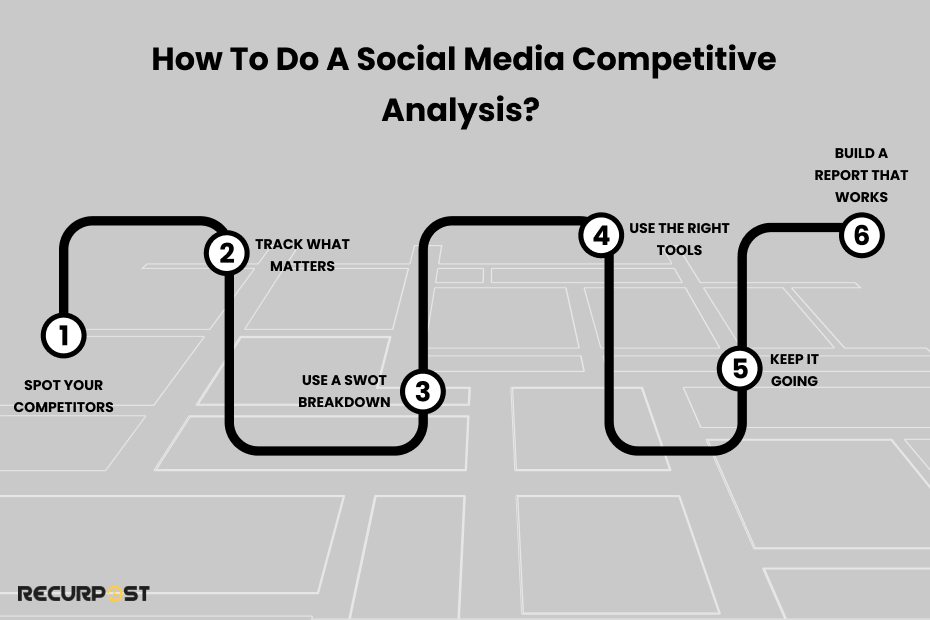
Step 1: Spot Your Competitors
Start by making a list of who’s fighting for the same audience. Look up brands through Google searches, check hashtags your followers like, and use social listening tools. Keep an eye on both direct and indirect competitors—they can teach you different things.
Step 2: Track What Matters
Once you’ve found your list, begin gathering numbers. Look at follower growth, post types, engagement patterns, and how often they publish. You can use a social media analytics template to stay organized.
Step 3: Use a SWOT Breakdown
Take what you’ve gathered and map out strengths, gaps, chances, and risks. This comparison shows where others win—and where you can step in.
Step 4: Use the Right Tools
Tools like Hootsuite, Similarweb, SEMrush, Rival IQ, and BuzzSumo let you see traffic patterns, ad content, and social behavior across platforms. A social media competitive analysis dashboard gives you everything in one place.
Step 5: Keep It Going
Don’t just check once. Set up a check-in every few months to see what’s changed. Brands shift fast—and so do their wins and misses.
Step 6: Build a Report That Works
Pull your data together into a solid document. Include competitor snapshots, growth trends, content habits, and clear notes on what your team should do next.
Real-World Social Media Competitive Analysis Example
Let’s see how a fictional fitness brand, FitLife, ran a full social media competitive analysis on its top rival, PowerFit:
Step 1: Spotting the Competition
FitLife used Instagram hashtags and Google searches for terms like “home workout equipment” to find direct competitors. PowerFit came out on top. They also tracked NutriWell, a supplement brand chasing the same crowd, as an indirect player.
Step 2: Tracking the Numbers
Over three months, FitLife logged key stats:
- PowerFit added 15,000 Instagram followers (8% jump), while FitLife grew by 9,000 (5%)
- PowerFit held a 4.2% engagement rate; FitLife had 3.1%
- PowerFit posts five times a week: 60% videos, 30% photos, 10% user content
- Their top hashtags: #homeworkout, #fitnesscommunity, #30daychallenge
Step 3: Running a SWOT Check
Here’s what the data showed:
- Strengths: PowerFit nailed video posts and group challenges
- Weaknesses: They ignored Twitter and replied slowly to comments
- Opportunities: They weren’t using small fitness creators under 100K followers
- Threats: PowerFit had a new product that matched FitLife’s top seller
Step 4: What FitLife Did
FitLife acted fast:
- Boosted video content to 65%
- Ran a 45-day fitness challenge with daily posts
- Partnered with 5 micro-creators with active followers
- Grew their Twitter presence to reach missed users
- Sped up their product release to stay ahead
Step 5: What Changed
In two months:
- FitLife’s engagement hit 4.5%
- Their growth rate reached 9.5%
- They outpaced PowerFit across both stats
This shows how a smart, step-by-step social media competitive analysis can shape moves that actually work.
Conduct a Comprehensive Social Media Competitor Audit
A social media competitive analysis audit digs deeper than basic analysis, helping you evaluate every aspect of a competitor’s social presence. Here’s how to run an audit that uncovers valuable insights:
1. Profile Assessment
Start by examining how your competitors present themselves across all platforms:
- Profile completeness: Are their profiles fully filled out and optimized?
- Brand consistency: Do they maintain the same voice and look across platforms?
- Visual quality: Are their profile and cover images high-quality and engaging?
- Effective bio/about sections: Do their bios clearly explain what they do and include clear CTAs (calls to action)?
- Branded keywords: Do they use hashtags and keywords that align with their brand?
2. Content Audit
Review 3-6 months of competitor content:
- Top-performing content: What themes, topics, or formats generate the most likes, shares, and comments?
- Content types: Are they using a good mix of videos, images, text posts, carousels, etc.?
- Tone and voice: Is their content professional, casual, humorous, or a mix?
- Storytelling: How do they craft their narrative? Are they telling a compelling story?
- Visuals: Are their visuals consistent with their brand’s image?
3. Audience Analysis
Look at who follows your competitors and how they interact:
- Audience size and growth rate: How fast is their audience growing on each platform?
- Demographics: Who exactly are they reaching (age, gender, location)?
- Interests and pain points: What does their audience care about, based on comment threads and engagement?
- Active segments: Which segments of their audience are most engaged?
- Sentiment: What is their audience’s sentiment toward the brand?
4. Engagement Evaluation
Measure how well competitors connect with their audience:
- Engagement rate: What’s their average engagement per post, and how does it vary by content type?
- Comment quality: Are comments positive, negative, or mixed?
- Response times: How quickly do they respond to comments and messages?
- Community management: How do they manage and grow their online communities?
- User-generated content: How much UGC do they share, and how does it align with their brand?
5. Campaign Review
Analyze their recent campaigns to see what’s working:
- Campaign messaging: What is the key message of their most successful campaigns?
- Cross-platform strategy: How do they integrate their campaign across platforms (Instagram, Facebook, TikTok, etc.)?
- Campaign timing and frequency: When are their campaigns launched, and how often?
- Promotions and offers: What type of special offers or discounts do they run?
- Campaign metrics: How do their campaigns perform (engagement, conversions, etc.)?
6. Competitive Gap Analysis
Identify opportunities for your own brand:
- Weak platforms: Are there platforms where they don’t have much presence?
- Underutilized content: Are there content types they aren’t using that could help them?
- Audience gaps: Are there audience segments they’re missing?
- Industry topics ignored: What key industry topics are they not covering?
- Execution weaknesses: Do they have technical or creative shortcomings?
Document Your Findings: Compile everything into a structured audit report, highlighting the gaps and actionable insights you can use to fine-tune your own social media strategy.
Use Competitive Insights for Your Social Media Marketing Strategy
Leverage competitive insights to fine-tune your social media strategy:
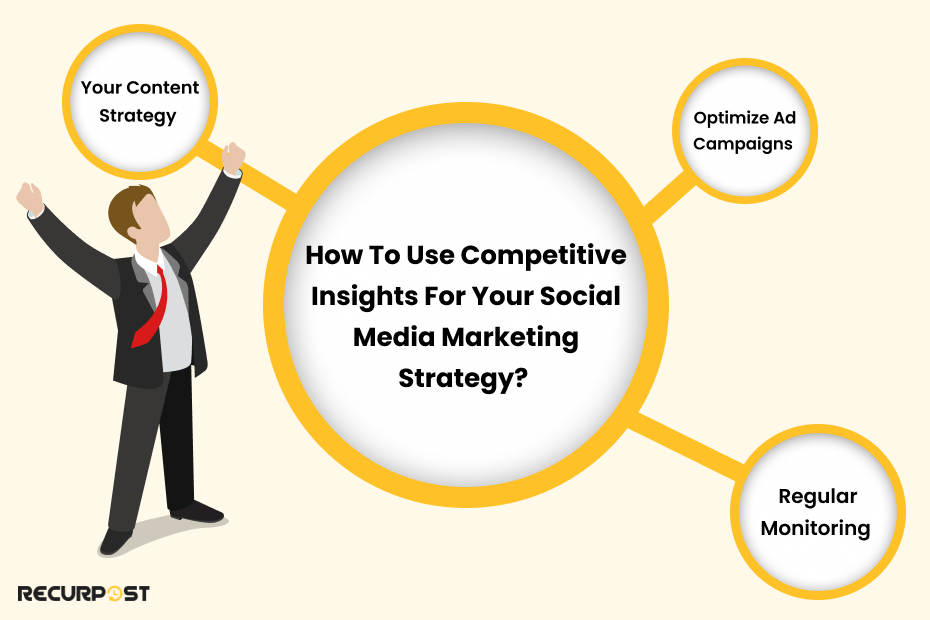
- Adjust Your Content Strategy: Take a fresh look at your content strategy by using what you learned from competitors. If you notice certain post types driving strong engagement for them, like videos or user-generated content, consider weaving them into your own strategy. Always keep your brand’s voice and message intact while adapting to what works.
- Optimize Ad Campaigns: Customize your ads by drawing from competitors’ successful formats. If video ads are getting more interaction them, focus more of your efforts on video content. Matching your ad formats to the most engaging content can help boost your ROI.
- Regular Monitoring: Social media evolves quickly. Set up quarterly or biannual audits to keep an eye on your competitors’ content strategy. This should include reviewing their posting schedule, the content types they’re using, and how their audience engages with their posts. Regular reviews help you stay on top of new trends and adjust your approach in real time.
Best Social Media Competitor Analysis Tools
These tools make social media competitive analysis quicker, easier, and more effective:
1. Hootsuite: Great for tracking follower growth and engagement across multiple platforms. Hootsuite simplifies data collection so you can focus on analyzing competitor content and engagement. It also supports Hootsuite competitor analysis for deeper insights into metrics. Hootsuite offers a free plan with limited features—ideal for small businesses.
2. Similarweb: Helps track how competitors’ social media activities translate into web traffic, providing a fuller picture of their impact. Similarweb’s free plan gives basic insights, though with limited data points.
3. SEMrush: A robust tool that offers in-depth competitor research and keyword insights to help refine your social media strategy. SEMrush’s free account comes with daily search limits.
4. Rival IQ: This tool provides comprehensive social media tracking and performance comparisons, letting you see how your metrics measure up to your competitors’. Rival IQ is primarily a premium service, but it offers free competitive reports for a snapshot of the data.
5. BuzzSumo: Perfect for identifying the most effective content types and popular topics in your industry. BuzzSumo offers a free plan, but with limited searches per day.
These tools automate data collection, saving you time. With more time to analyze trends, you can refine your social media strategy and stay ahead of competitors rather than spending time sifting through raw data.
Conclusion
Social media competitive analysis helps digital marketers stay ahead and set industry benchmarks. By regularly reviewing your social media competitive analysis, you can refine your own strategy, making data-driven decisions that fuel growth in an ever-evolving market.
If you’re just getting started, begin with basic competitor tools and key metrics. As you gain experience, scale your analysis efforts. Regular audits ensure your social media strategy remains fresh, relevant, and competitive.
What is your plan for social media competitive analysis?
Download Free Templates
Frequently Asked Questions
1. What’s the best frequency for competitive analysis on social media?
A good rule of thumb is to conduct a social media competitive analysis quarterly or biannually. This allows you to track how industry trends are evolving, benchmark your performance against competitors, and make timely strategy adjustments.
2. Can competitive analysis improve ad campaigns on social media?
Yes. By analyzing your competitors’ ad strategies, you can review their messaging, visuals, offers, and targeting to refine your own ads. This helps improve engagement and conversion rates for your campaigns.
3. How do I get started with tools for social media competitive analysis?
Start with free trials of tools like Hootsuite or Similarweb to get a feel for how social media competitive analysis can enhance your efforts. In the meantime, use your platform’s native audience analytics tools to track growth and engagement.
4. How often should I conduct a social media competitive analysis?
Social media competitive analysis should be done quarterly or biannually. This ensures you’re keeping up with trends and adjusting your strategy based on the latest data.
5. Is it necessary to monitor indirect competitors?
It’s recommended to perform social media competitive analysis quarterly or biannually to stay on top of trends and adjust your strategy based on the most recent data.
6. What’s the biggest mistake to avoid in social media competitive analysis?
One common mistake is focusing solely on follower count. Engagement rates and the quality of interactions with followers are much more important metrics to track.
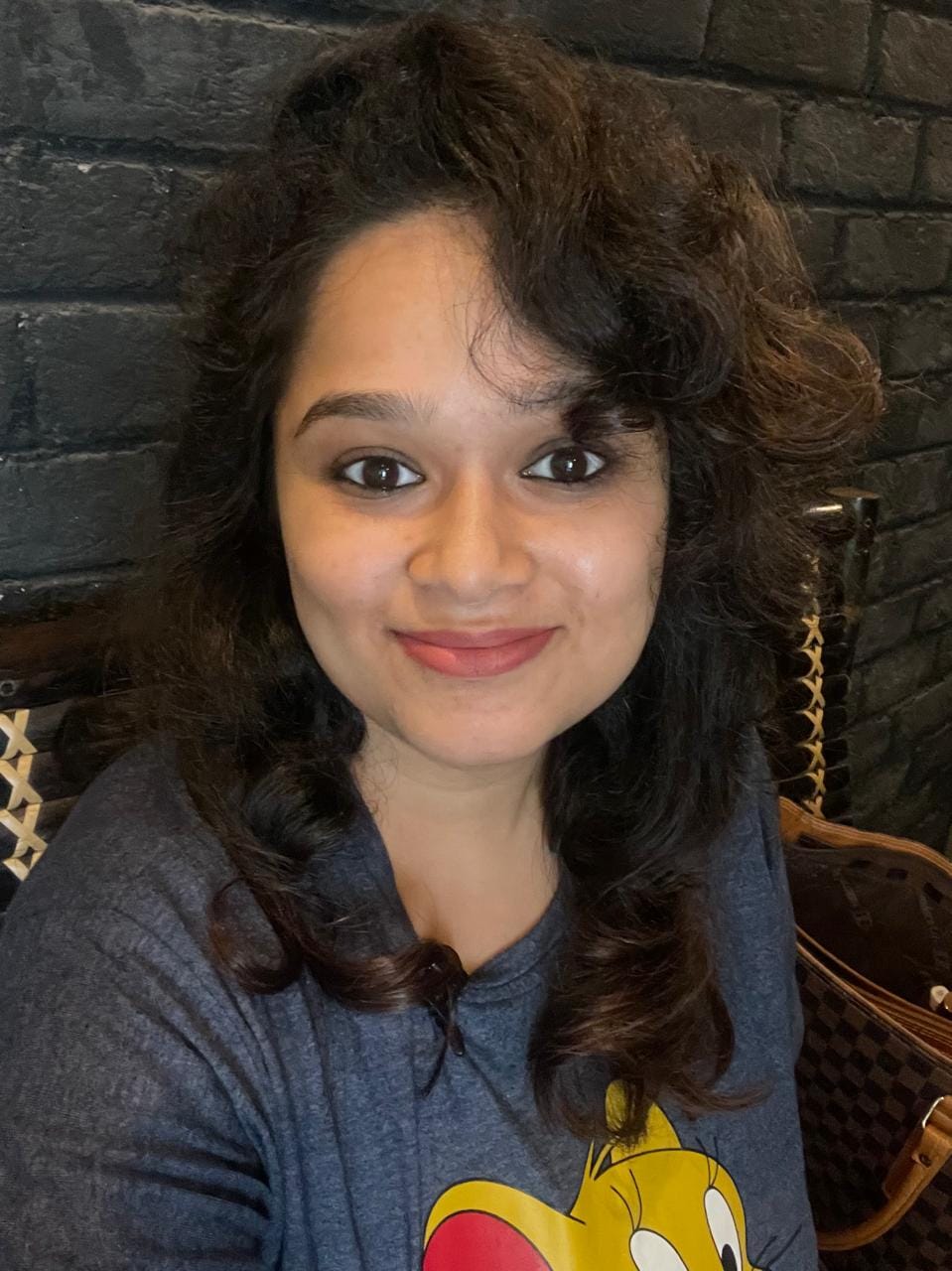
Ruchi Dhimar is a skilled content writer with 5 years of experience. She is passionate about crafting compelling narratives, specializing in writing content for different industries.
